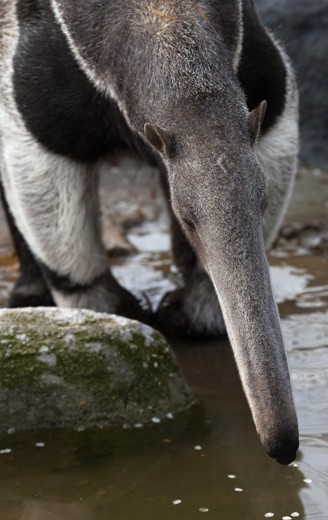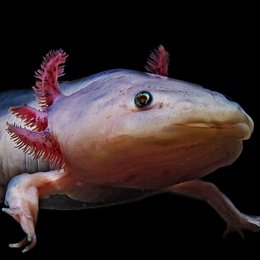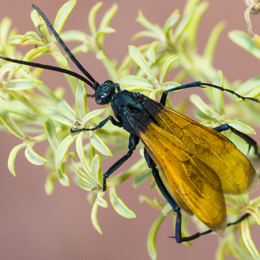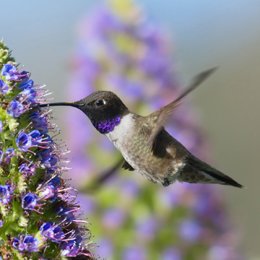Giant Anteater
Besides the Grizzly, there is another bear that roams in the wild of America; the Ant bear or more commonly known as the Giant Anteater. As the name suggests, the Giant Anteater is the largest species of anteaters out of three. They are found mainly in wild habitats of South and Central America. As the animal feeds mainly on ants and termites, it is often termed as an insectivorous mammal.
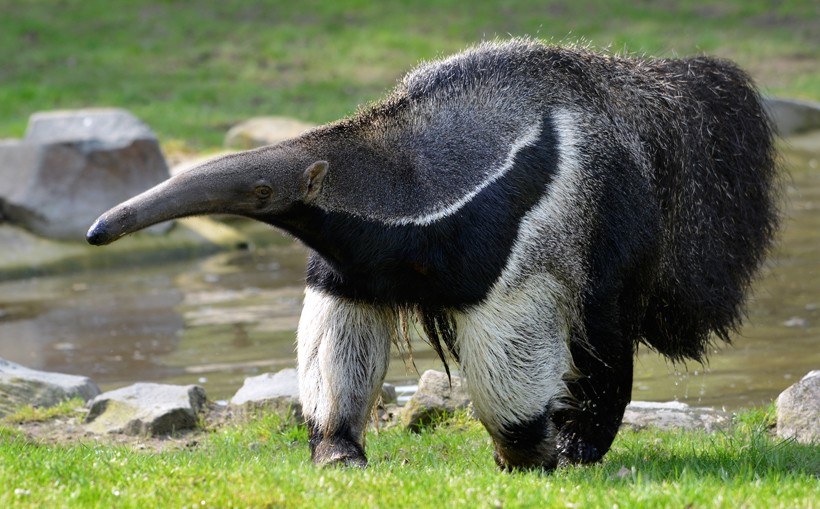
The Giant Anteater walks by putting its weight on the front knuckles which keep the claws out of the way during movement.
?
Image credits: Christian Musat/Shutterstock
Giant Anteaters are often labeled as strange-looking animals due to their distinctly long nose which lends a unique shape to their head. This elongated snout, in addition to the long fore-claws, bushy tail and specifically colored pelage makes them easily recognizable. The heads and necks of the male anteaters are wider than that of the females’ and they are also more muscular and somewhat larger than the female counterparts. As the major physical differences between male and female are located internally, the visual sex determination becomes extremely difficult. In many cases, the female Giant Anteaters are identified due to the accompaniment of their young ones.
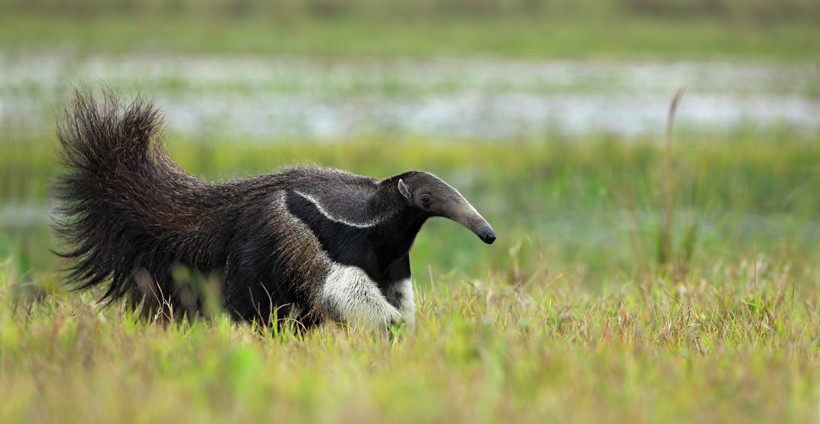
Running giant anteater
?
Image credits: Ondrej Prosicky/Shutterstock
The average lifespan of a Giant Anteater is between 14 - 16 years. The length of the adult Giant Anteater is normally between 5 to 7 feet and the males of this species weigh around 33 – 41 kg whereas females weigh between 27 - 39 kg. The head of this anteater is particularly elongated and stretches up to 12 inches in length. The major portion of the head is taken up by the tubular snout that culminates with the small nostrils and tiny mouth opening. The eyes and ears of this creature are comparatively smaller in size which renders the Giant anteater with poor eyesight. However, its highly sensitive nose compensates for the poor eyesight as the sense of smell of Giant anteaters is 40 times stronger when compared to the humans. In fact, it is their sense of smell that helps them to find food and also to escape from their predators which make it one of the most important organs for their survival.
Relatives
There are four species of anteaters among which the Giant anteater (Myrmecophaga tridactyla) is the largest in size and heaviest in weight. The three other species are – Silky Anteater (Cyclopes didactylus), Northern Tamandua (Tamandua Mexicana) and Southern Tamandua (Tamandua tetradactyla).
Silky Anteaters are also found in South and Central American forests and it is the smallest species of anteaters discovered till date. The adult Silky Anteater weighs between 175 to 400 gram and their length is found to be only between 14 – 18 inches with most of its length taken up by the tail. Its body is as small as a squirrel’s body and the silky soft fur is endowed with a distinct silvery sheen which led to the name ‘Silky Anteaters.’
The Southern and the Northern Tamanduas are two subspecies of anteaters that belong to the Tamandua genus. Like the other anteater species they are native to South and Central America. Both the Tamanduas are semi-arboreal in nature and occupy both forests and grasslands. Moreover, both have partially prehensile tails. Like the Giant Anteaters, they are devoid of teeth and depend on ants, termites, beetles, bees and insect larvae. However, unlike the Giant anteater, the Tamanduas are not capable of galloping and move rather awkwardly on the surface.
Besides the three species, sloths and armadillos are the two close relatives of the Giant Anteater and share the same super-order, Xenarthra.
Anatomy and Characteristics
The large size along with the elongated snout and thick bushy tails are some of the prominent external visual characters that help in identifying a Giant Anteater. Besides this, the anteaters' body is covered by a coarse dense fur which is either black or dark brown in color with white around the forelegs and black bands over the wrists. A stripe of black fur edged with a very thin line of either white or gray fur stretches across the chest and ends at the mid-section of its back. The Giant Anteater has broad ribs and each foot has five toes. The front feet toes have claws except for one and the third and second toes are particularly elongated. Like gorillas and chimpanzees, the Giant Anteater walks by putting its weight on the front knuckles which keep the claws out of the way during movement.
In contrast to the long claws on the front feet, the claws on the hind feet are shorter which allow them to walk in a plantigrade manner. Moreover, the large front claws along with the powerful forelegs provide them the ability to break open the termite mounds with just a single swipe and also helps in defending against predators. In fact, there are reports that Giant Anteaters killing Pumas and Jaguars during self-defense.
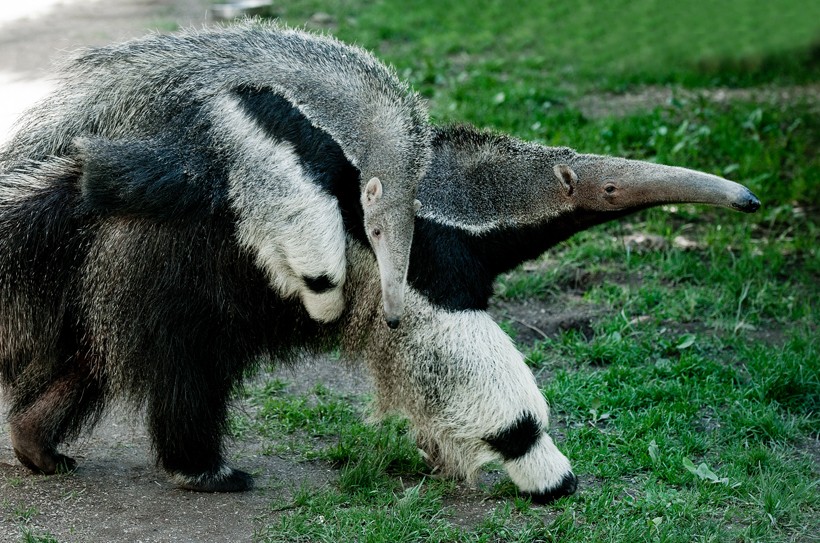
The black and white bands are perfectly aligned, providing the young with camouflage
?
Image credits: Andreas Gradin/Shutterstock
The Giant Anteater has limited jaw movement and has no teeth. However, this is compensated by the 24 inches long sticky tongue which is triangular posteriorly, round anteriorly and containing a rounded tip. They have large salivary glands that help in producing huge amounts of saliva which is very sticky in nature. The ants, termites and larvae stick to its tongue because of this saliva whenever it breaks their nest and puts in its tongue. By flexing the lower jaw, the ants and termites are swallowed easily and very quickly. While eating, the tongue of the Giant Anteater shoots out almost 150 times per minute which allows them to swallow 30,000 ants every single day. They have a muscular stomach that not only grinds the immense amount of insects within just a few hours but also secretes powerful digestive juice for breaking down the prey once they are inside the stomach.
Habitat
The Giant Anteater is primarily found in the Central and South American grasslands, swamps, rainforests and humid forests. The habitat range stretches from Honduras all the way to Northern Argentina. Even though their territory includes humid forests and swamps, they are seen mostly on the grasslands because of their readily available prey of termites and ants. The mammals keep on traveling constantly for food as they avoid destroying their food source completely in a particular area. In fact, the Giant Anteaters have been found to use multiple habitats for survival. They generally forage on the grasslands and open areas and walk afterwards to forested areas to rest because the forest provides a cool environment on hot days and warm environment on cold days.
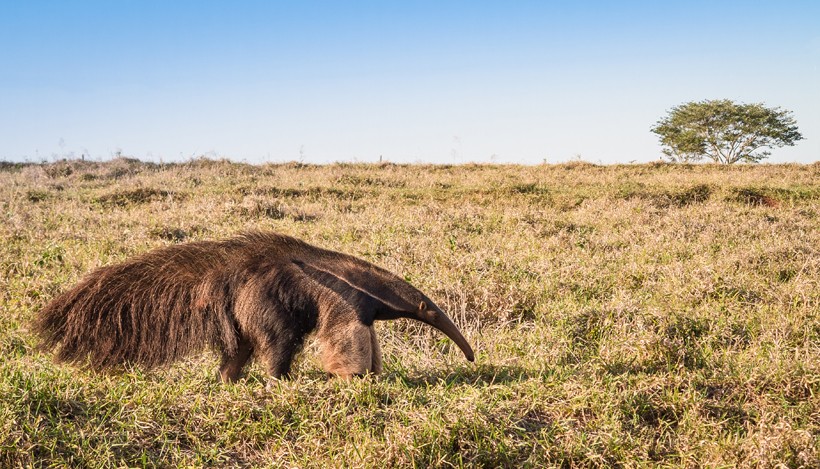
Giant anteater in its natural habitat
?
Image credits: Luciano Queiroz/Shutterstock
However, originally Giant Anteaters are not typically seen in the Andes. Mass extirpation of Giant Anteaters took place in the regions of Uruguay, Belize, Guatemala and Costa Rica due to human-induced factors like hunting and destruction of their habitats, attacks by dogs and deforestation. They are very vulnerable to fire because of their flammable coat and slow movements. In the year 1994, it has been estimated that a total of 340 Giant Anteaters were burnt to death due to a gruesome wildfire at the Emas National Park in Brazil.
Diet, Hunting and Predation
Diet
Giants Anteaters are insectivores whose diet mostly involves ants and termites. The anteaters that live on the Venezuelan grassy flood plains feed mainly on ants because of less availability of termites while the anteaters of the Emas National Park feed mostly on termites due to its high-density occurrence. On the other hand, the anteaters at Serra da Canastra switch their diets from ants to termites depending on the wet and dry season.
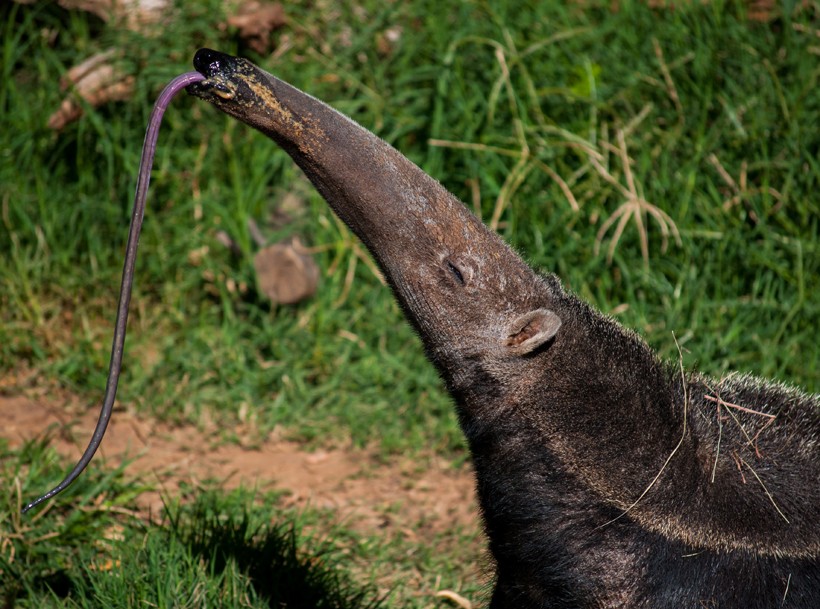
The Giant Anteater flicks out its tongue 150 times a minute when eating insects.
?
Image credits: esdeem/Shutterstock
Hunting
The highly sensitive nose of Giant Anteaters helps them track their prey by following the scent. Once it finds a nest, the anteater puts inside its long and sticky tongue by tearing the nest open with the help of its long fore-claws for collecting the prey. It visits up to 200 hundred nests per day spending only a minute or so on a single nest and consuming an average of 30,000 insects.
Even though Giant anteaters eat ants all the time, they are not exactly immune to the biting attacks of the soldier ants which is why they keep on moving most of the time and doesn’t spend more than a minute in one nest. Other preys of this anteater are beetle larvae and the western honey bees who build their hives in the termite mounds. For drinking, they are also seen to dig for water with their sharp front claws during the absence of surface water, thereby leaving waterholes for other forest animals.
Predation
Jaguar, Pumas and mountain lions can prey on the Giant Anteaters but avoid it if they find other prey because of the anteater’s long fore-claws that always inflicts injury to the predator during self-defense. Normally, they gallop to flee from danger but if they are cornered, they try to slash the attackers by rearing up on their short clawed hind legs. They are typically shy animals and will try to avoid disturbances by fleeing from the scene but if threatened, they are capable of inflicting severe injuries and even kill other animals including humans.
Reproduction and life cycle
There are no specific breeding seasons for Giant Anteaters as they can mate throughout the year. For mating, a male anteater follows and sniffs the female and is also seen foraging together and eating from the same insect nests. While they mate, the female lies down on one side and the male remains crouching over her. They engage in mating several times during the period they stay together which can last to a maximum of three days. The gestation period of an anteater is 190 days and the female gives birth by standing upright.
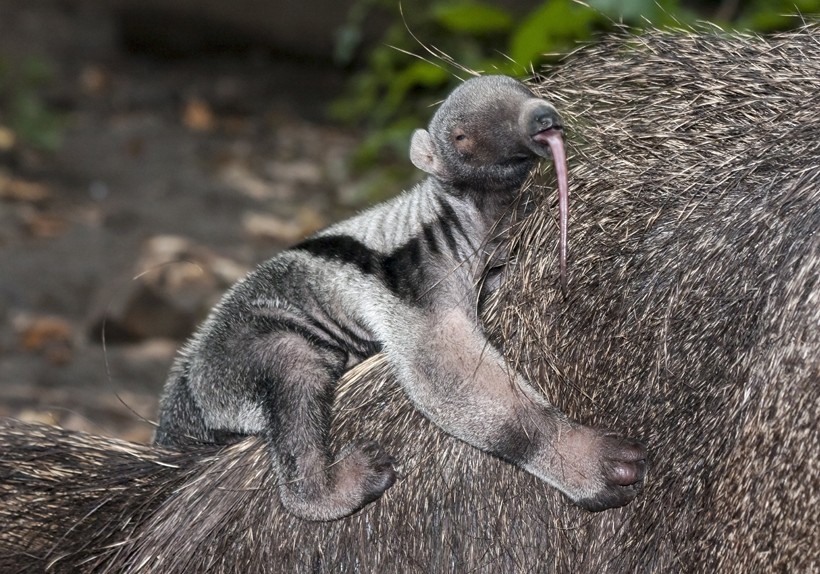
Mother with newborn giant anteater on her back
?
Image credits: belizar/Shutterstock
The young one of the Giant Anteater is called a pup and they give birth to a single pup. When the pup is born it normally weighs around 1.4 kg or 3.1 lb. The young ones are born with their eyes closed and they only open them after a period of six days. After three months they become able to eat solid food. The weaning period lasts up to nine or ten months. During this period, the mother protects the young by carrying it on her back while hunting. It also serves as a camouflage for the young as the black & white band of the pup perfectly aligns with the mother’s band.

The mother protects the young by carrying it on her back while hunting
?
Image credits: belizar/Shutterstock
With the end of the weaning period after ten months, the pup becomes independent and starts hunting on its own thereby weakening the mother and offspring bond gradually. The anteaters become sexually mature by 2.5 to 4 years and by that time they become a fully grown adult.
Behavior, Communication and Intelligence
Giant Anteaters are considered to have both diurnal and nocturnal characteristics with nocturnal being the dominant one. When the temperature is low during the night and early morning, the anteaters remain highly active and with the rise of temperature they retire and keep on resting. However, during the winter when the temperature drops they become diurnal and switch over their hour of activities to daytime.
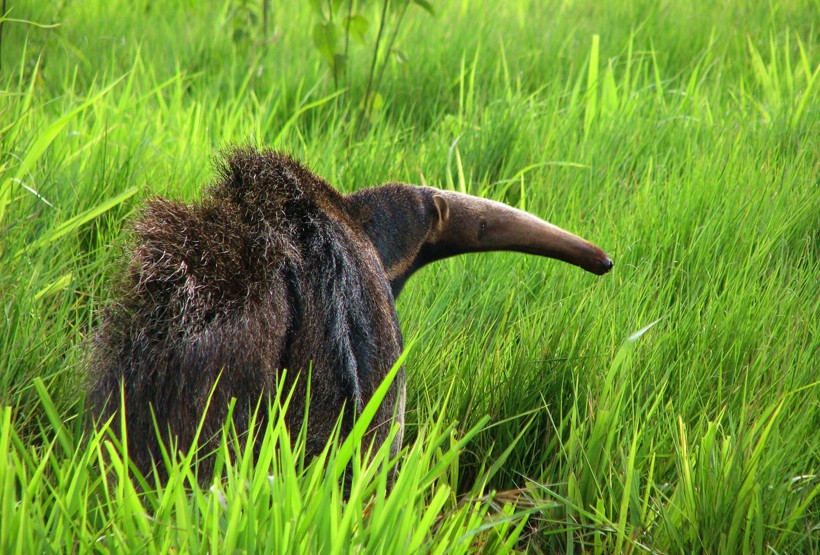
Giant anteater bonito in Brasil
?
Image credits: Nestor Noci/Shutterstock
Giant Anteaters choose tall grasses as a place of resting during the cold days in contrast to the dense brush which they use as resting abode in the summer. They often dig the ground and carve out a shallow cavity to rest and they curl up and cover their body with their long bushy tail during sleep. The tail keeps their body warm and also serves as a camouflage. Giant Anteaters are good swimmers with the capability to move through wide rivers and there are even instances of anteaters indulging bathing themselves.
Characteristically, Giant Anteaters are loners and are seen alone unless they are mating or nursing their young ones. They generally communicate their sexual condition, presence and status by a special secreted chemical substance that is produced by their anal glands. They also use urine and tree marking for advertising their presence in the area. Anteaters use the saliva scent to recognize each other and female anteaters are more tolerant to other females compared to the tolerant capacity of males. Males are also territorial in their behavior and when confronted with other males they might indulge in fighting during which they roar and bellow.
Population and Conservation
Although Giant Anteaters are not considered as an endangered species, they have lost a considerable amount of their population due to deforestation, habitat destruction and hunting. Until recently, the Giant Anteaters were commonly hunted in places like Bolivia, Venezuela and some other parts of South America for sport, claws and its thick leathery hide which were used for making equestrian equipment. According to the latest estimate, there are only 5000 of Giant Anteaters left in the forests of South and Central America.
Cultural depictions
Giant Anteaters often appear as a trickster and a humorous figure in the folklores and mythological stories of the indigenous people that reside in the Amazon basin.
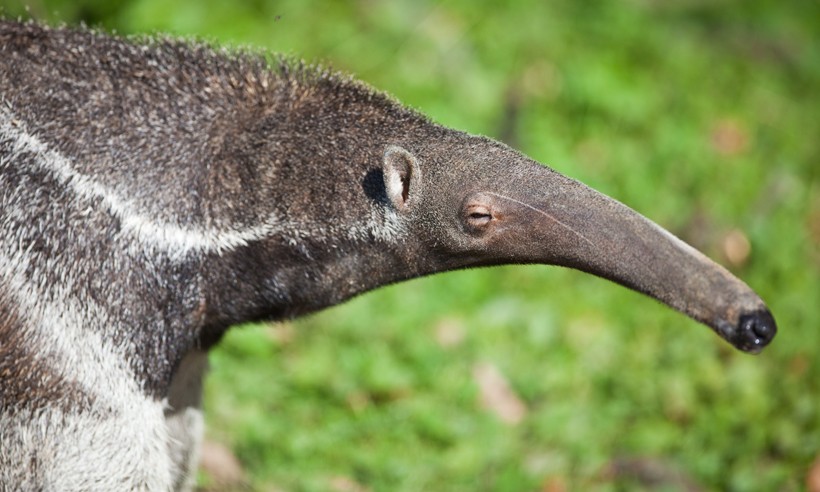
Closeup head giant anteater
?
Image credits: l i g h t p o e t/Shutterstock
In a Shipib tale, the anteater is said to have tricked a jaguar and stole its pelt by challenging him to an underwater breath-holding contest. In the initiation and naming ceremonies of the Kayapo people, they often use a mask resembling an anteater for speculating the future. Moreover, when the Europeans first colonized America they took many anteaters to Europe for displaying them in the European zoos. They also harbored a popular misconception that all the anteaters were females who had to mate with their noses until it was corrected by Felix de Azara, a prominent naturalist of the 18th century.
Evolutionary history
The Giant Anteaters have lived in its present form for around 25 million years and are a close relative to the present day sloths with whom it shares the order Pilosa. Between the epochs of Eocene and Paleocene around 55 million years ago, the sloths and anteaters diverged to form different evolutionary characteristics. There are not many fossil records of anteaters and the few that exists proves it to be a close relative of the Silky Anteater and the Tamanduas. The only well-represented fossil record of the Giant Anteater is from the early Holocene and late Pleistocene epoch. According to evolutionary studies, the ancestors of the Giant Anteaters today were either arboreal or semi-arboreal in nature and their transition to complete terrestrial life might have been initiated by the expansion of immense open habitats like the Savanna in South America which provided an abundant source of food in the form of colonial insects.
Funfacts
- Giant Anteaters have a very poor eyesight but have an extremely sensitive nose which is equivalent to the sensitiveness of 40 human noses put together.
- Anteaters doesn’t possess teeth.
- Giant anteaters usually remain silent all the time and avoid making any kind of sound unless they are in a fight.
- The Giant Anteater is completely terrestrial unlike the three other anteater species.
- The Giant Anteater flicks out its tongue 150 times a minute when eating insects.
- It has a 2 feet (24 inches) long tongue which is filled with thousands of tiny hooks.
- The Giant Anteaters are inherently loners.
